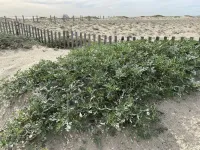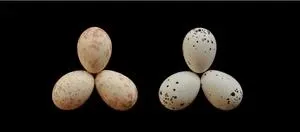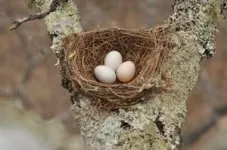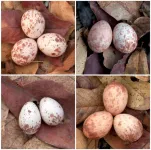(Press-News.org) (Santa Barbara, Calif.) — Over the last several years, the residents of Santa Monica, a coastal city on the edge of Los Angeles, saw something neither they, their parents, or perhaps even their grandparents had ever seen before: a three-foot-tall dune system rising gently from the flat, groomed expanse of one of the world’s most famous urban beaches. It’s a six year alliance between sand, wind and vegetation, and, according to UC Santa Barbara researchers, it’s one way to enlist nature to help protect the coast from the impacts of climate change.
“The project was really to assess whether we could naturally grow dunes on a heavily urbanized, mechanically raked beach that had been that way for more than 70 years,” said Karina Johnston, a doctoral student at UCSB’s Marine Science Institute (MSI) and the Bren School for Environmental Science & Management, and lead author on a paper in Frontiers in Marine Science. “Could it work? Could it inform natural solutions to help protect our coastline from sea-level rise?” The short answer: quite possibly.
The threat of sea-level rise has become an issue for all coastal cities around the world as they grapple with warming oceans, more intense storms and flooding events. For heavily populated stretches of coast, such as Santa Monica Beach in Los Angeles, the issue is especially nuanced: City planners have to walk the line between protecting the coast and keeping it available to the millions of visitors it receives each year.
“At the start of the project, considerations were centered around balancing ecology, beach access and the needs of local residents and businesses,” said Shannon Parry, chief sustainability officer for the City of Santa Monica. “Given the popularity of Santa Monica Beach, the project needed to be interactive and accessible.”
Beach grooming (or raking) is a coastal management measure undertaken generations ago to pick up trash, remove seaweed and make the beach more appealing for visitors.
“Those management activities have been in place for decades on urban beaches, so it’s created an institutionalized construct of what a beach should look like,” Johnston said.
Though well-intentioned, the practice of heavily raking the top few inches of sand several times a week and picking up kelp wrack does keep the beach free of debris, but it also flattens the natural landscape of wind-swept dunes held together by natural vegetation, impacts biodiversity and reduces habitat for wildlife. These unnaturally wide stretches of sand have since become the iconic look of southern California beaches, with coastal cities spending millions of dollars each year to maintain it.
But with the growing threats of climate change and sea level rise, people who study and manage California’s urban beaches are taking another look at beach grooming. In collaboration with the City of Santa Monica and The Bay Foundation and other partners, Johnston and MSI researchers Dave Hubbard and Jenifer Dugan started a long-term experiment, sectioning off three sides of a 1.2 hectare (about 3 acre) stretch of Santa Monica Beach with sand fencing, and sowing native dune plant seeds (red sand verbena, beach bur, beach salt bush and beach evening primrose). Then they waited.
And waited.
And waited, conducting scientific surveys throughout the study period, and turning to UCLA postdoctoral researcher Kyle Emery to document the long-term results via drone surveys.
“The success of the project was evident on the ground, but the aerial view from the drone provided an entirely different perspective in which the restoration site stood out like an island within a groomed landscape,” Emery said. “The data we collected with the drone surveys allowed us to build digital elevation models and estimate the sand accumulation and increase in elevation of the restoration site relative to the adjacent beach.” Six years after it began, the general elevation across their pilot study area increased by about 0.3 meter (about 1 foot), including a higher foredune ridge with a 0.9 m maximum elevation and 1-m dunes along the perimeter. The accumulation of sand into dune forms was assisted by native vegetation, which trapped sand as it blew into the area, forming hummocks and dunes .
Humans weren’t the only ones who noticed the new landforms; shorebirds, and especially the threatened western snowy plover, had started to make use of the new dune landscape to roost.
Waiting for nature and conducting scientific research was probably the easier job. The collaborators simultaneously undertook a massive information campaign aimed at the local beach community, explaining what the project was for and what they could expect.
“The City of Santa Monica was a fantastic partner,” Johnston said. “They are very forward-thinking about climate change.” City staff dedicated time and effort to sending out mailers, building a website, generating blogs and leveraging social media. They also added informative signs at the site to explain the importance of coastal resilience and set up meetings so the researchers could directly answer any questions from the public.
What’s important to remember, according to the researchers, is that human involvement was also part of the vision. “What we really wanted to do was to let people interact with the site and to not impact recreational opportunities,” Johnston said. Hence, while the area was marked off with signs requesting minimal disturbance, the oceanward side of the plot was unfenced to open it to recreation.
The public response was “incredibly positive,” according to the researchers, due in large part to the access provided for recreation, and to a walkway through the experimental plot. It became so popular that that people would go out of their way to walk through the middle of the site on their way to the water’s edge and take pictures or birdwatch.
Not everyone was enthusiastic about the project from the start. One longtime resident was vocal in her opposition to the project at the beginning of one public comment gathering session.
“We started giving a presentation about why the project was happening, and our goals, and we started showing pictures of other places that had dunes and vegetation along the beaches, and she stands up in the middle of the presentation. I froze: What was she going to say?” Johnston recalled.
“And she turns to the City of Santa Monica and stares at them and says, ‘Why is this project not bigger?’ She became one of our staunchest supporters, and we recognized the important value of community input throughout the process.”
“The Santa Monica Beach Pilot Project is a successful proof of concept for scalable, affordable coastal adaptation solutions that address the risks from climate change and coastal sea level rise,” Parry noted. “Through dedicated public engagement and thoughtful ecological design, the project was able to strike a balance between allowing sensitive natural processes to take place and achieving accessibility for Santa Monica beachgoers and residents.”
For all this effort, however, are the new dunes going to do what everyone hopes they will do?
“The dune building is going faster than the current rate of sea level rise,” Hubbard said. “So that’s really good. You could even have a disturbance and it could rebuild itself and catch up again.”
The last round of winter storms provided some evidence of this resilience, something the researchers hope will buy time as Santa Monica adapts to coastal erosion and climate change. But time, and even bigger storms and wave action will tell whether Nature can rise to the challenge of protecting the urban coast.
Not all groomed beaches will respond to nature-based interventions such as this. Santa Monica Beach is part of a local littoral cell that naturally receives sand cycled in by wave and wind. “This approach is going to be suitable in some areas,” Hubbard said. “It’s not appropriate for other areas that are narrower.”
However, the success of this venture so far is something the scientists hope will inspire other sandy beach researchers and managers to investigate as a possibility for nature-based coastal adaptation. Ideally, field experiments and monitoring should last as long as it takes to gauge factors such as how large dunes can get, whether or not vegetation can re-seed itself and if the dune can self-repair after a significant disturbance. This could take up to a decade.
“One of the highlights of this study is that we actually tracked this project from the beginning and out to more than six years,” Dugan said. Most of the studies they encountered in preparation for this project had done only a few years of monitoring and thus provided incomplete knowledge on the effects of rewilding sections of beach. She suspects that some of these short-term projects could have reported higher levels of response had there been a longer period of monitoring.
“Now we have all this rich information,” she said. “We know which plants really built the dunes, and where the foredune was likely to form on this groomed beach. All these findings can be applied to other coastal dune restoration projects.”
For now, the collaboration will continue to monitor the experimental site, especially as this ongoing El Niño weather cycle brings higher sea levels and bigger waves. More information means more options for adaptation.
“We’re not doing this project in a prescriptive way,” Hubbard said. “We’re trying to create an alternative vision of what southern California beaches can be and people can choose for themselves what kind of beach they can have.”
END
Dune restoration could increase the resilience of Southern California's urban beaches to sea level rise
2023-07-26
ELSE PRESS RELEASES FROM THIS DATE:
How to stop obese children having heart disease in adulthood
2023-07-26
Sophia Antipolis, 26 July 2023: Childhood is a window of opportunity to tackle obesity before the damage it causes is irreversible, according to a scientific statement by experts on heart disease and childhood obesity published today in the European Journal of Preventive Cardiology, a journal of the European Society of Cardiology (ESC).1 The document was produced by the Task Force for Childhood Health of the European Association of Preventive Cardiology (EAPC) of the ESC and the European Childhood Obesity Group (ECOG).
Childhood obesity is on the rise. According to the World Health Organization, while less than 1% of children and adolescents aged 5-19 were obese in 1975, ...
Static isometric exercise, such as wall sits, best for lowering blood pressure
2023-07-26
Static isometric exercises—the sort that involve engaging muscles without movement, such as wall sits and planks—are best for lowering blood pressure, finds a pooled data analysis of the available evidence from clinical trials, published online in the British Journal of Sports Medicine.
But ‘cardio’ (aerobic exercise); dynamic resistance training, such as squats, press-ups, and weights; high intensity interval training or HIIT for short (episodic short bouts of high intensity exercise ...
Consequences of premature parental death seemingly greater for boys than for girls
2023-07-26
The cumulative health and economic consequences of the premature loss of a parent may be greater for boys than for girls, suggest the findings of a large long term study published online in the Journal of Epidemiology & Community Health.
Experiencing the death of a parent before the age of 21, however, is strongly linked to poor mental health and lower earnings/unemployment in adulthood for both sexes, the data indicate.
Previously published research has pointed to a link between premature parental death and the child’s subsequent health and prosperity. But no studies have drawn ...
Study finds ‘startling’ levels of hidden mental health symptoms among people living with long term autoimmune diseases
2023-07-26
More than half of patients with auto-immune conditions experience mental health conditions such as depression or anxiety, yet the majority are rarely or never asked in clinic about mental health symptoms, according to new research from the University of Cambridge and King’s College London.
In a study published today in Rheumatology, researchers found that over half of the patients had rarely or never reported their mental health symptoms to a clinician, and that the range of possible mental health and neurological symptoms is much wider than has been previously reported.
The team surveyed neurological and psychiatric symptoms amongst 1,853 patients with systemic auto-immune ...
Egg ‘signatures’ will allow drongos to identify cuckoo ‘forgeries’ almost every time, study finds
2023-07-26
Images and paper available at: https://drive.google.com/drive/folders/1mPYnFKIEArlXUAaFk5H7YTepezntqerj?usp=sharing
African cuckoos may have met their match with the fork-tailed drongo, which scientists predict can detect and reject cuckoo eggs from their nest on almost every occasion, despite them on average looking almost identical to drongo eggs.
Fork-tailed drongos, belligerent birds from sub-Saharan Africa, lay eggs with a staggering diversity of colours and patterns. All these colours and patterns are forged by the African cuckoo.
African cuckoos lay their eggs in drongos’ nests to avoid rearing their chick themselves (an example of so-called ...
A novel approach for balancing properties in composite materials
2023-07-26
Dr. Amir Asadi, an assistant professor in the Department of Engineering Technology and Industrial Distribution at Texas A&M University, is making groundbreaking strides in the field of composite materials. His research explores embedding patterned nanostructures composed of multiple materials into high-performance composites to achieve the desired multifunctionality without sacrificing any other properties. This could lead to advancements in various fields, including electronics, energy storage, transportation and consumer products.
Asadi's work has significant implications, as it addresses the challenge of simultaneously enhancing two properties — multifunctionality ...
One simple brain hack might boost learning and improve mental health
2023-07-25
DURHAM, N.C. – Shifting from a high-pressure mindset to a curious one improves people’s memory.
New research from Duke found that people who imagined being a thief scouting a virtual art museum in preparation for a heist were better at remembering the paintings they saw, compared to people who played the same computer game while imagining that they were executing the heist in-the-moment.
These subtle differences in motivation — urgent, immediate goal-seeking versus curious exploration for a future goal — have big potential for framing real-world challenges such as encouraging people ...
$13.7 million NIAID grant will fund novel study on multidrug resistant organisms
2023-07-25
The National Institute of Allergy and Infectious Diseases (NIAID) has awarded a $13.7 million, five-year grant to a team of researchers to investigate multidrug resistant organisms (MDROs) in nursing homes throughout the United States.
The multidisciplinary research team includes CUNY Graduate School of Public Health (CUNY SPH) Professor Bruce Y. Lee and is led by University of California, Irvine (UCI) School of Medicine infectious diseases expert Dr. Susan Huang.
Using one of the world’s largest compilations of specimens from healthcare facilities, the team will study six antibiotic-resistant organisms deemed as serious and urgent ...
Protein found to protect females against obesity
2023-07-25
RIVERSIDE, Calif. -- Associated with poorer mental health outcomes and reduced quality of life, obesity is on the rise in the United States. Currently, more than 30% of American adults are classified as obese. A risk factor for several diseases, including diabetes, cardiovascular disease, and COVID-19, obesity is an important and growing public health concern.
Using a mouse model of high fat diet-induced obesity, a team of scientists at the University of California, Riverside, has found that, compared to males, female mice are protected against obesity and inflammation because they secrete more of an immune protein called RELMalpha.
“Our ...
Enhancing image quality with broadband achromatic and polarization-insensitive metalenses
2023-07-25
Precise control of light is a crucial requirement in optical imaging, sensing, and communication. Traditional lenses employed for the purpose have limitations, necessitating more precise and compact solutions. To address this need, researchers have developed metalenses, ultrathin lenses constructed from nanomaterials that are smaller in size than the wavelength of light. These sub-wavelength elements provide the means to manipulate light waves with exceptional precision, facilitating a precise control of the amplitude, phase, polarization, and direction of light waves.
Moreover, compared to bulky lenses, metalenses are ...






